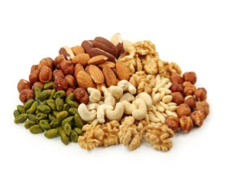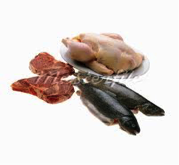Difference between revisions of "Nutritional Value of Major Food Groups"
(→Major Food Groups) |
(→Major Food Groups) |
||
| Line 55: | Line 55: | ||
|- | |- | ||
|[[Image:major_food_groups2a.png|thumb|center|150px|Source: [http://www.hd-wallpapers9.com/Photos/Vegetables/Vegetables%20Hd%20Wallpapers/24 hd-wallpapers9.com]]] | |[[Image:major_food_groups2a.png|thumb|center|150px|Source: [http://www.hd-wallpapers9.com/Photos/Vegetables/Vegetables%20Hd%20Wallpapers/24 hd-wallpapers9.com]]] | ||
| − | |[[Image:major_food_groups2b.png|thumb|center|150px|Source: | + | |[[Image:major_food_groups2b.png|thumb|center|150px|Source: Google images]] |
|'''Vegetables''' and '''fruits''' are important sources of micronutrients and dietary fibre but the amounts vary. Orange vegetables and fruits, such as carrots, mango and papaya are excellent sources of vitamin A. Most fruit and fresh (not overcooked) vegetables provide vitamin C. Dark green vegetables supply folate and (pro-)vitamin A. It is important to eat a variety of vegetables and fruits. | |'''Vegetables''' and '''fruits''' are important sources of micronutrients and dietary fibre but the amounts vary. Orange vegetables and fruits, such as carrots, mango and papaya are excellent sources of vitamin A. Most fruit and fresh (not overcooked) vegetables provide vitamin C. Dark green vegetables supply folate and (pro-)vitamin A. It is important to eat a variety of vegetables and fruits. | ||
|- | |- | ||
Latest revision as of 03:41, 8 June 2016
Nutrients are necessary to make the body function well. They provide energy, help the growth and repair of the body and protect the body against illness. The table below presents the main use of macro- and micronutrients in the body.
Table: Uses of some important nutrients
| Nutrient | Main use in the body |
| Macronutrients | |
| Carbohydrates – starches and sugars | To provide energy needed to keep the body breathing and alive, for movement and warmth, and for growth and repair of tissues. Some starch and sugar is changed to body fat. |
| Carbohydrates – dietary fiber | Fiber makes faeces soft and bulky and absorbs harmful chemicals, and so helps to keep the gut healthy. It slows digestion and absorption of nutrients in meals, and helps to prevent obesity. |
| Fats | To provide a concentrated source of energy and the fatty acids needed for growth and health. Fat aids the absorption of some vitamins such as vitamin A. |
| Proteins | To build cells, body fluids, antibodies and other parts of the immune system. Sometimes proteins are used for energy. |
| Water | To make fluids such as blood, tears, sweat and urine and to allow chemical processes to happen in the body. |
| Micronutrients | |
| Iron | To make hemoglobin, the protein in red blood cells that carries oxygen to the tissues. To allow the muscles and brain to work properly. |
| Iodine | To make thyroid hormones that help to control the way the body works. Iodine is essential for the development of the brain and nervous system in the fetus. |
| Zinc | For growth and normal development, for production and to keep the immune system working properly. |
| Vitamin A | To prevent infection and to keep the immune system working properly. To keep the skin, eyes and lining of the gut and lungs healthy. To see in dim light. |
| B-group vitamins | To help the body use macronutrients for energy and other purposes. To help the nervous system to work properly |
| Folate | To make healthy red blood cells and to prevent abnormalities in the fetus. |
| Vitamin C | To aid the absorption of some forms of iron. To destroy harmful molecules in the body and help wound healing. |
Major Food Groups
 Source: drmcdougall.com |
Staple foods include cereals and starchy roots and fruits. They are usually cheap and supply plenty of starch (for energy), some protein, some micronutrients (especially some of the B-group vitamins and dietary fibre. | |
 Source: hd-wallpapers9.com |
Vegetables and fruits are important sources of micronutrients and dietary fibre but the amounts vary. Orange vegetables and fruits, such as carrots, mango and papaya are excellent sources of vitamin A. Most fruit and fresh (not overcooked) vegetables provide vitamin C. Dark green vegetables supply folate and (pro-)vitamin A. It is important to eat a variety of vegetables and fruits. | |
 Source: beanergize.wordpress.com |
 Source: glossophilia.org |
Legumes, seeds and nuts are good sources of protein, some micronutrients and dietary fibre. In addition nuts and legumes like soybeans provide fat. |
 Source: svsaqua.com |
Dairy products are excellent sources of protein, fat and many micronutrients, such as calcium. Eggs are a good source of protein and fat and several micronutrients.
Breast milk can supply all the nutrients needed for the first six months of life and a useful proportion of the nutrient needs up to at least 2 years of age. | |
 Source: mosthealthyfood.com |
Meat, poultry and fish are excellent sources of protein and often fat. They supply important amounts of iron (especially red meat) and zinc, and many other micronutrients including some B-group vitamins. | |
Note: sugar gives only energy and no other nutrients. It makes foods taste nice and helps to improve appetite, for instance during illness. However, eating sugary foods too often can be harmful to health as it is bad for the teeth. Many sugary foods also contain much fat, which increases the risk of ‘overeating’, becoming overweight and developing diabetes.
Acknowledgements
- FAO 2004. Family nutrition guide, by A. Burguss with P. Glasauer. Rome


